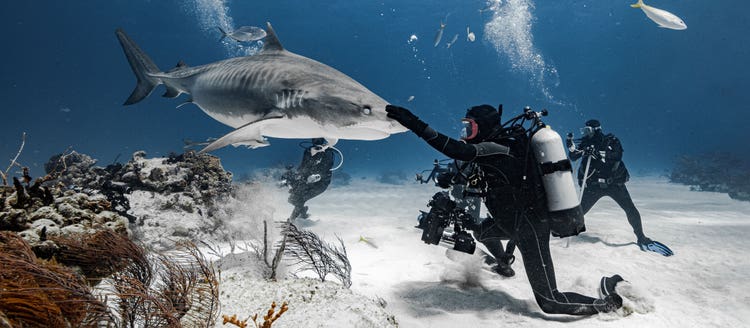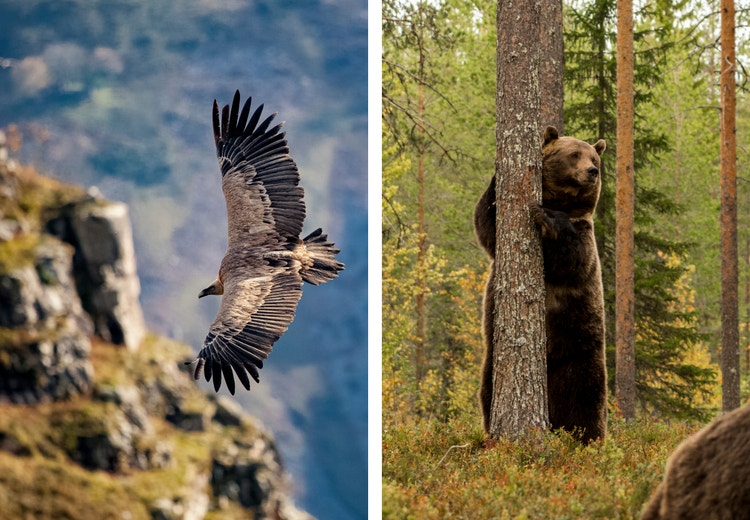Talking with tiger sharks: Patrick Masse’s images bring us into conversation with the animal world

Image credit: Adobe Stock / Patrick Masse
Creating simple, beautiful, and evocative images of 60,000-pound mammals like Humpback whales requires a highly-trained professional with a wealth of experience: someone with the eye of an artist, the body of a serious athlete, and the mind of a scientist. It requires someone like Patrick Masse.
In this article
- The meandering path
- Tools of the trade
- Every photograph is a conversation
- Who has the right to our planet?
Over the last few decades, Masse has traveled across equatorial shoals, West Indian reefs, arctic tundra, remote mountains, and Yucatan cenotes documenting everything from great white sharks and manta rays to griffon vultures and brown bears.
His commercial and stock imagery portfolios are the result of years of work, refinement, adaptation and plenty of close encounters. Adobe Stock was thrilled to sit down and speak with Masse about what it takes to create his work.

Image credit: Adobe Stock / Patrick Masse, Adobe Stock / Patrick Masse.
The meandering path
Patrick Masse’s life hasn’t been a straight shot to swimming with Tiger sharks. Before his current life scuba diving off Tonga and hiking in the Pyrenees, Masse was at various points a fighter pilot and a diver.
“I'm like a cat,” says Masse, “I've had several lives.” Masse grew up on the North African Coast and enjoyed spearfishing. Eventually his love of the creatures he was skewering superseded the thrill of the hunt; he wanted to be able to see the same creatures more than once. So, as he likes to say, “I exchanged my harpoon for a camera.”
As he refined the craft of keeping cameras dry, himself oxygenated, and his presence innocuous, Masse began to get some interesting job offers. One such job, in the Bahamas, required coordinating with a large team of ocean videographers to get 20 minutes of footage of sharks. “The problem was that the sharks do not stay in front of a camera for 20 minutes,” he remembers. To address this challenge, swimmers dumped fish bait in front of different operators. It was an exercise in learning to adapt in real-time, stay calm, and realize that ocean animals won’t sit around and wait for you.
Over time, his freelance career grew to owning a photo agency, representing up to 70 photographers. Masse loved supporting other photographers and getting their images to a paying audience, but he didn’t love spending so much time marketing images, and less time creating them.
This is one reason he’s returned to working for himself. That's easier now than before, he says, in part because companies like Adobe Stock handle the business of housing, promoting, and distributing his images. “I can now focus on the shooting and leave the business part to Adobe Stock,” he reflects.

Image credit: Adobe Stock / Patrick Masse.
Tools of the trade
While scuba diving and camping out in the subarctic can have a romantic Jack London sense of adventure, ultimately Masse’s profession is photography, and he aims to create images that capture the beauty, mystery, and incredible diversity of nature.
Over the course of his long and varied career, Masse’s constantly refining his approach to lighting, framing, and other aesthetic skills as much as he is his practical ones.
Take lenses for example. Some situations demand extremely wide lenses. When trying to capture a humpback whale, Masse knew he needed to capture a creature over fifty feet long in one frame. He also knew that water is less transparent than air, so the farther you go away, the darker the image becomes. Only an extremely wide angle lens would allow him to stay close enough to the whales to see them and get them in one frame.
Vultures, wolves, and bears, on the other hand, need extremely long lenses. These animals have very keen senses and are cautious, elusive, and fast. You need to be able to camp out quietly in one spot and the moment one comes into view, know that your lens can actually make an animal far away occupy a fair amount of the frame.
Masse loves to explore new technologies and is always looking for gear that is lighter, more resilient, and versatile. For him, the greatest improvement is the creation of cameras that can produce both high quality still images and video. “We’re bringing in much less gear now,” he says “and it’s made me completely mobile.”
https://main--blog--adobe.hlx3.page/media_19b90665117f6bcb74004a7c43f5bd959b6444aa0.mp4
Video credit: Adobe Stock / Patrick Masse.
Every photograph is a conversation
There is an inherent tension between our desire to see nature as it exists far away from human interference and the fact the act of seeing nature means literally putting ourselves (or a robotic proxy) inside it. Masse confronts this on a daily basis in his work: the tension between letting animals go about their lives and being cognizant of how his presence will, inevitably, affect them.
To Masse, every photograph is a conversation between him and his subjects. The wolves and bears and sharks he has devoted his life to documenting are just as aware of his presence as he is of theirs.
While many people might prefer to escape the notice of large predators like sharks, for Masse, after diving with them “thousands” of times, it’s just a fact that they know you’re there. “There’s no point in being afraid,” he says “but you do have to be careful. Prudence is the mother of safety.”
This prudence is certainly tested in ways most people would find terrifying. “Often, sharks will come and try to touch you,” he says “but they don’t have hands. They touch with the tip of their nose.” And rows of very sharp teeth are never very far from that nose. Luckily, Masse says the camera is what they usually go for first, an object they find boring enough to leave after touching it.
Perhaps Masse’s greatest skill lies in his respect for, and understanding of, animal psychology and nature. He approaches every photograph, every adventure, as a knowing exchange between two species, rather than a simple act of hunting down prey to catch in a moment unaware.
While he will use bait or migratory patterns to increase his chances — or for dolphins, bring a couple of toys for them to play with — for Masse, “the ocean has no borders. The animals could very well be elsewhere. When you are in the water, you realize that an animal has chosen to come and meet you and offer you some of its time.”
He likes to talk about the time he swam with a humpback whale and her cub as he was snorkeling. For hours he noticed the eyes of the whales would follow him and the other divers. “They were just as curious as we were,” he remembers, “we had established a trust between us.”

Image credit: Adobe Stock / Patrick Masse, Adobe Stock / Patrick Massev.
Who has the right to our planet?
Like many creatives in recent years, Masse has had to adapt from business pre-Covid — 36-hour flights across the globe, cramped boat rides — to a world of lockdowns and halts in travel. “My usual hunting ground was the Pacific, so I had to resign myself to stay closer and look for the land animals,” he says.
With this shift, he focused on large terrestrial predators, like the wolves and bears of Finland, as well as the majestic bearded vultures in the Pyrenees. Masse explains his predilection for apex predators as a love for the creatures that represent a complex ecosystem. These predators are the most vulnerable to our changing planet, he says: “If one of the links disappears, a cascade of disappearances will follow.”
Masse’s next big trip will be to Australia. “It’s the last continent where I have not set foot professionally. I want to see the Great Barrier Reef before it’s gone,” he says. But he continues to become more and more curious about his own European backyard, especially the up near the arctic. After his recent trip to Finland, he’s planning an expedition to Norway.
Masse feels the impact of climate change personally: every time he returns to a location for a shoot, he takes note of the march of global warming and pollution.
He hopes his work will bring awareness, not just to spur action, but to remind us of the moral obligation we have to our fellow species. “This diversity and this freedom that we have,” he says “we must share with the other inhabitants. They have, like us, the right to live there.”
See more of Patrick Masse’s photography and underwater videography on Adobe Stock. Feeling inspired? Contribute your own images and video clips to Adobe Stock.